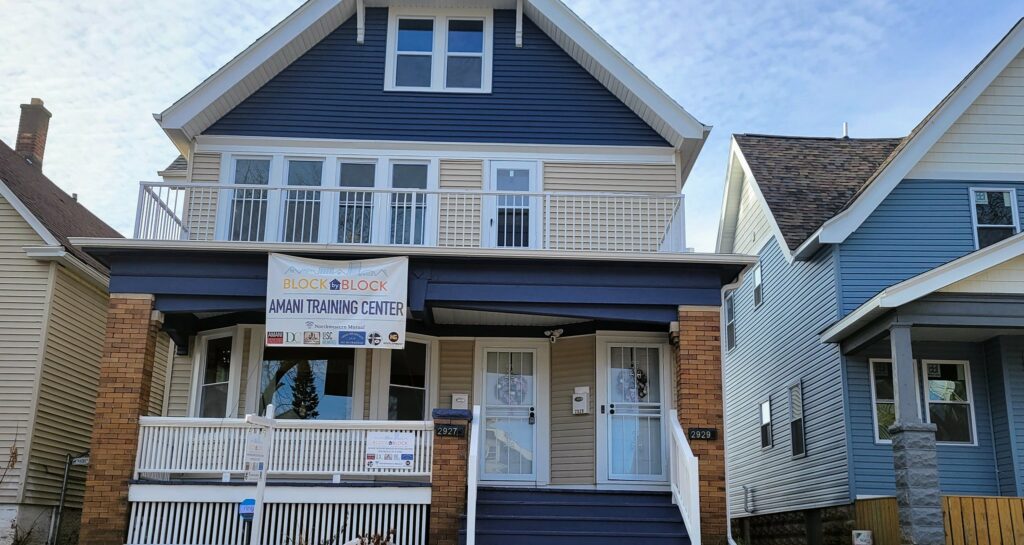Outside Investors, Labor Shortage Hamper Milwaukee Affordable Housing Efforts
But groups pushing forward on effort to create 5,000 new homeowners of color.

Ezekiel Community Development Corporation has a training center for construction trades in Milwaukee’s Amani neighborhood. Photo by PrincessSafiya Byers/NNS.
A labor shortage and outside investors who snap up properties have created a double whammy that’s impeding efforts to boost affordable housing in Milwaukee.
For the past few years and especially since the pandemic, out-of-state investors have been buying up and renting single-family homes and duplexes throughout the city.
According to an article by Mike Gousha and John D. Johnson for the Milwaukee Journal Sentinel, “out-of-state investors now own 7,170 single family homes, condos, duplexes or triplexes across the city, up from 5,250 at the end of 2018.”
Gousha is senior adviser in law and public policy and Johnson is a research fellow at the Lubar Center for Public Policy Research and Civic Education at Marquette University Law School.
Most recently, the Community Development Alliance, a group that focuses on neighborhood improvement efforts, and Acts Housing, a housing counseling agency, have partnered on a goal to create 5,000 new homeowners of color in Milwaukee by the end of 2025.
Acts Housing is working via its new acquisition fund to address the barriers low-income families face when trying to buy homes. The fund will be used to purchase Milwaukee homes that will be resold to residents at affordable prices.
“There is not enough skilled labor in construction or any of the allied trades,” said Kurt Paulsen, a professor of urban planning at the University of Wisconsin-Madison. “Roofing, electric, HVAC; none of those areas have enough contractors to do the job.”
Paulsen said the city’s best bet is rehabbing and improving the quality of existing homes — but even that poses an economic challenge.
“Buying a home that is in disrepair means getting a mortgage big enough to fix it,” he said. “No one is going to write a $120,000 loan for a home that cost $80,000.”
Chris Garrison, the construction and operations director for Milwaukee Habitat for Humanity, said that even for an organization that has been in the business of building for so long, finding contractors can be a struggle.
“We have good relationships with some contractors, and they are willing to work with us, but they seem to be getting busier and busier,” he said. “It can also be a struggle to have all the equipment they need to build a home on a small city lot.”
“Sometimes, because of things like crime, contractors don’t want to work somewhere,” he said. “Or if they are working there and get things stolen or damaged, they don’t want to come back.”
Garrison said Habitat is proud that it was able to build 20 homes last year but is constantly concerned about whether what it does is enough to move the needle.
“We do what we can like everyone else,” he said. “But I think it is safe to say a lot of businesses in the industry are shorthanded and could use more help”
Paulsen sees the city’s housing challenges as an opportunity for community development.
“Funding the nonprofits already doing the work paired with on-the-job training and other resources can help create the capacity and infrastructure to do this work on the scale it needs to be done,” he said.
“We try to consider how we can build smarter, faster, greener and better,” he said. “And because we are Wisconsin, we only have about eight months (of good weather) to build, so we think about how we can build inside and then move parts outside.”
He said there is some work being done to address the labor shortage in construction, specifically by the Ezekiel Community Development Corporation, a construction company that trains workers.
Despite the challenges, everyone agrees that more can be done.
“We know what works,” Paulsen said. “It’s a huge price to pay, but there will be a greater cost to society if we don’t.”
Housing resources
Check out housingplan.org.
For more information and resources, check out Take Root Milwaukee.
Labor shortage, outside investors strain affordable housing efforts in Milwaukee was originally published by the Milwaukee Neighborhood News Service.





















